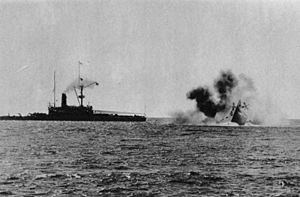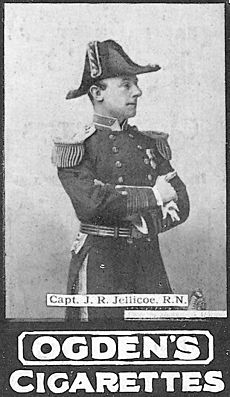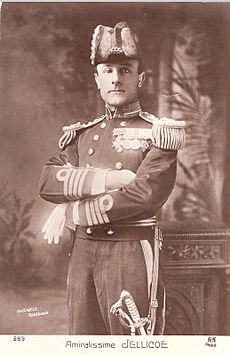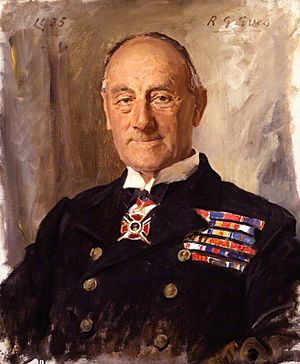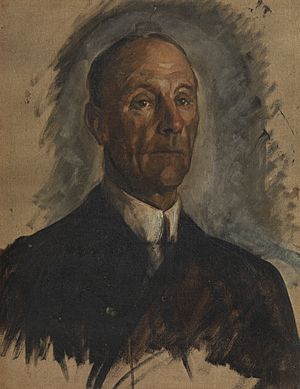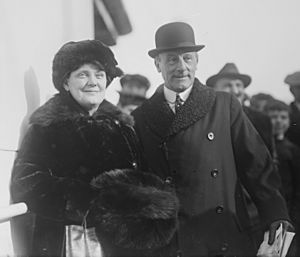John Jellicoe, 1st Earl Jellicoe facts for kids
- This page is about the Admiral for the Fleet. See John Jellicoe (disambiguation) for pages about others with the same or similar name.
Quick facts for kids
The Earl Jellicoe
|
|
|---|---|
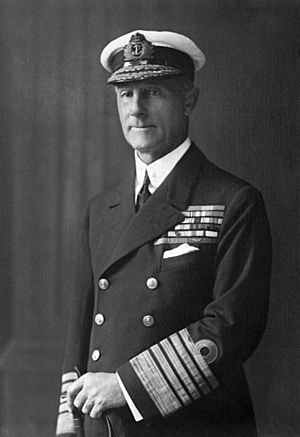 |
|
| 2nd Governor-General of New Zealand | |
| In office 27 September 1920 – 12 December 1924 |
|
| Monarch | George V |
| Prime Minister | William Massey |
| Preceded by | The Earl of Liverpool |
| Succeeded by | Sir Charles Fergusson |
| Member of the House of Lords Lord Temporal |
|
| In office 1 July 1925 – 20 November 1935 Hereditary peerage |
|
| Preceded by | peerage created |
| Succeeded by | The 2nd Earl Jellicoe |
| Personal details | |
| Born | 5 December 1859 Southampton, Hampshire, England |
| Died | 20 November 1935 (aged 75) Kensington, London, England |
| Military service | |
| Allegiance | United Kingdom |
| Branch/service | Royal Navy |
| Years of service | 1872–1919 |
| Rank | Admiral of the Fleet |
| Commands | First Sea Lord Grand Fleet Atlantic Fleet HMS Drake HMS Centurion |
| Battles/wars | Anglo-Egyptian War Boxer Rebellion First World War |
| Awards | Knight Grand Cross of the Order of the Bath Member of the Order of Merit Knight Grand Cross of the Royal Victorian Order Sea Gallantry Medal |
Admiral of the Fleet John Rushworth Jellicoe, 1st Earl Jellicoe (born December 5, 1859 – died November 20, 1935) was a very important officer in the Royal Navy. He took part in the Anglo-Egyptian War and the Boxer Rebellion. He is best known for leading the Grand Fleet at the Battle of Jutland in May 1916 during the First World War.
After the battle, some people debated his decisions. However, Jellicoe made no major mistakes. The German fleet had to retreat, which was a big win for Britain. If Britain had lost, it would have been a disaster. But the public wanted a bigger victory because the British fleet was larger. Jellicoe later became the First Sea Lord. In this role, he helped expand the navy's staff and introduced convoys to protect ships. He also served as the Governor-General of New Zealand in the early 1920s.
Contents
John Jellicoe was born in Southampton, England. His father was a captain in a shipping company. John joined the Royal Navy in 1872 when he was just 12 years old. He started as a midshipman on a training ship.
He became a sub-lieutenant in 1878 and a lieutenant in 1880. In 1882, he fought in the Egyptian War. He led a group of naval soldiers during a battle.
Jellicoe became a gunnery officer in 1883. This meant he was an expert in naval guns. He received a special medal in 1886 for saving the crew of a capsized ship near Gibraltar. He was promoted to commander in 1891.
In 1893, he was on the battleship HMS Victoria. This ship was the main ship of the Mediterranean Fleet. Sadly, it crashed with another ship and sank off Tripoli in Lebanon. Jellicoe survived this accident.
He became a captain in 1897. He then served as Captain of the battleship HMS Centurion. During the Boxer Rebellion in China in 1900, he was badly wounded. Doctors thought he would die, but he recovered. For his bravery in China, he received an award called the Companion of the Order of the Bath. He also received a German award.
Rising Through the Ranks
Jellicoe was a close friend and supporter of Admiral John Fisher. Fisher was a very influential figure in the navy. In 1905, Jellicoe became the Director of Naval Ordnance. This role put him in charge of the navy's weapons. He was promoted to rear admiral in 1907.
He strongly pushed for new funds to make the navy more modern. He supported building new, powerful battleships like the Dreadnought and battlecruisers. He also supported new fire-control systems for guns, which helped ships shoot more accurately.
In 1907, Jellicoe became second-in-command of the Atlantic Fleet. He then became the Third Sea Lord and Controller of the Navy in 1908. This job involved managing the navy's equipment and ships. In 1910, he became the Commander-in-Chief of the Atlantic Fleet.
He was promoted to vice admiral in 1911. By 1912, he was the Second Sea Lord, a very high position in the navy.
World War I Leadership
Leading the Grand Fleet
When the First World War began in August 1914, Jellicoe was promoted to full admiral. He was given command of the Grand Fleet, which was Britain's main battle fleet. This was a huge responsibility.
Jellicoe led the British Grand Fleet at the Battle of Jutland in May 1916. This was the biggest naval battle of the war. It was the only major clash between the large battleships of Britain and Germany. The battle did not have a clear winner.
Some historians say Jellicoe was too careful during the battle. Others blame Admiral David Beatty for mistakes. However, Jellicoe did not make any major errors. He correctly positioned his fleet. The German fleet eventually turned away and retreated.
The British public was disappointed because they wanted a huge victory like the Battle of Trafalgar. But Winston Churchill later said that Jellicoe was "the only man on either side who could lose the war in an afternoon." This meant Jellicoe's careful approach was smart. He was awarded the Order of Merit and the French Legion of Honour for his service.
Becoming First Sea Lord
In November 1916, Jellicoe became the First Sea Lord. This was the highest professional role in the Royal Navy. During his time in this role, German submarines (U-boats) were sinking many British ships. This put Britain in danger of running out of food and supplies.
At first, Jellicoe and other admirals were against using convoys. Convoys are groups of merchant ships traveling together, protected by warships. They thought convoys were too big a target and that merchant captains couldn't keep their ships in formation.
However, after much discussion and pressure, convoys were slowly introduced. By August 1917, convoys were widely used. This helped reduce the number of ships sunk by U-boats.
Jellicoe was dismissed from his role as First Sea Lord in December 1917. This decision was made by Eric Campbell Geddes, the First Lord of the Admiralty, and David Lloyd George, the Prime Minister. It was a sudden and surprising move.
After the War
After the war, Jellicoe was given the title Viscount Jellicoe in 1918. He was promoted to Admiral of the Fleet in 1919, the highest rank in the Royal Navy.
In September 1920, he became the Governor-General of New Zealand. This meant he was the King's representative in New Zealand. He served in this role until 1924. When he returned to England in 1925, he was given an even higher title: Earl Jellicoe.
John Jellicoe died in London on November 20, 1935, at the age of 75. He was buried in St Paul's Cathedral, a very important church in London.
Family Life

John Jellicoe married Florence Gwendoline Cayzer in 1902. She was the daughter of a wealthy shipping owner. Lord and Lady Jellicoe had one son and five daughters. Their son, George Jellicoe, 2nd Earl Jellicoe, also had a distinguished military career during the Second World War. He later became a well-known politician and businessman.
Honours and Awards
John Jellicoe received many honours and awards throughout his life for his service to the country.
Ribbon bar (incomplete)
Titles and Peerages
- Viscount Jellicoe of Scapa in the County of Orkney – 7 March 1918
- Earl Jellicoe and Viscount Brocas of Southampton in the County of Southampton – 1 July 1925
British Awards
- Knight Grand Cross of the Order of the Bath (GCB) – 1915
- Order of Merit (OM) – 1916
- Knight Grand Cross of the Royal Victorian Order (GCVO) – 1916
- Sea Gallantry Medal (SGM) – 1886
British Medals
- Egypt Medal
- China War Medal (1900)
- 1914-15 Star
- British War Medal
- World War I Victory Medal
- King George V Coronation Medal
- King George V Silver Jubilee Medal
International Awards
 Kingdom of Prussia : Order of the Red Eagle, 2nd class with crossed swords – 1902 (Germany)
Kingdom of Prussia : Order of the Red Eagle, 2nd class with crossed swords – 1902 (Germany) France : Grand Cross of the Legion of Honour – 1916 (France)
France : Grand Cross of the Legion of Honour – 1916 (France) Belgium : Grand Cordon of the Order of Leopold – 1917 (Belgium)
Belgium : Grand Cordon of the Order of Leopold – 1917 (Belgium) Russian Empire : Order of St. George, 3rd Class – 1917 (Russia)
Russian Empire : Order of St. George, 3rd Class – 1917 (Russia) Kingdom of Italy : Grand Cross of the Military Order of Savoy – 1917 (Italy)
Kingdom of Italy : Grand Cross of the Military Order of Savoy – 1917 (Italy) Empire of Japan : Grand Cordon of the Order of the Paulownia Flowers – 1917 (Japan)
Empire of Japan : Grand Cordon of the Order of the Paulownia Flowers – 1917 (Japan)
International Decorations
- Navy Distinguished Service Medal of the United States – 1919 (USA)
- Croix de Guerre of France – 1919 (France)
- Belgian Croix de Guerre – 1917 (Belgium)
- Khedive's Star of Egypt – 1882 (Egypt)
See also
 In Spanish: John Jellicoe para niños
In Spanish: John Jellicoe para niños


